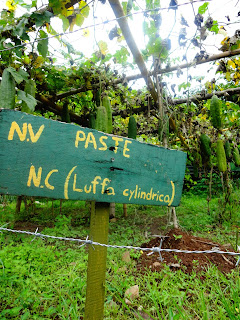I am finally well
rested. I am still up far earlier than I would prefer but I feel more in my own
mind than I have in a few days. Breakfast at our hotel came with a startling
and disturbing revelation – a pool and hot tub had been tucked away around the
corner from my room all night long. Had I discovered this fact earlier I would
be prune-skinned, less slept, and blissfully happy. Trade-offs. We left our La
Fortuna hotel to the sight of the Arenal
Volcano puffing a short string of
smoke, a sight that had even the locals gazing at the peak which is often
obscured by cloud cover. Our hot spring going friends last night had been
soaking at its base where, on occasion, one can chance the sight of lava
streams rolling down the hill under starlight. One thing you learn in traveling
is not to spend too much time lamenting the experiences you do not have.
The drive was
beautiful though uneventful. We passed Lake Arenal and caught glimpses of a family of
monkeys resting in the treetops. We made a quick pit stop and, with quick snack
options limited to cookies and potato chips, I opted for a bag of fresh made
tortillas and a confection made of shredded coconut and
condensed milk.
The road to Monteverde was long and slow, twisting through the hills and rising above the
lowlands affording a view of the Caribbean Sea to the east and the Pacific
Ocean to the west. The green rolling pastures with grazing cattle and mountain
forests both contrasted the bright blue sky with its puffs of white cloud and
islands in oceans on far off horizons. Even for people traveling from the
beautiful Pacific Northwest who are not strangers to a stunning vista were awed
by the picturesque scene and were camera-ready to capture the glory of it. I clicked,
and giggled. The gravel roads to the town have deteriorated with time and
weather conditions which locals believe has hurt the tour industry there. In
fact, community members in Monteverde staged a protest that shut down a section of the
Pan-American Highway to demand better upkeep of the road.
We arrived in Monteverde and were greeted by caravans of local folks who were there to whisk about
half our group away to their home for the first of two home-stay opportunities
on the trip. The home stays here were set up by a woman who works with the
local Spanish language school who
also makes such arrangements for their students. Alicia and I arranged to
have the experience together and, when our names were called, we were greeted
by Maria, a lovely woman in her late 50’s with a warm smile and serious
face. She was accompanied by her two granddaughters, Alison, 8, and Nahomy, 9.
We took a short taxi ride just a few blocks and walked the rest of the way of a
short hill toward her home. It was a simple structure with a large glass
sunroom facing toward the mountains and the town.
We put our things away and were offered a lunch of garbanzo bean and chicken soup with a side of rice and fresh salad. This easily sits in the top 5 meals I have eaten in Costa Rica. We spoke a little, Alicia translating with her Spanish skills. We were joined by her daughter-in-law, Rebeca with 8 month old granddaughter, Alexandra, on her hip. Again, with the babies - each one makes me happy enough to want a plane ticket home and the adoption paperwork. I got a few smiles out of Alexandra but she did not take well to grandma's attempt to set her on my lap. We simply don't know one another well enough for that level of intimacy yet. Sign. Maybe tomorrow.
Alicia and I
gussied ourselves and walked back toward town alone, Maria having already made
her way to the church for Sunday evening mass. We joined our group outside the
church, warmed up, and walked in singing Ariko. We sang 18 songs with great
response from the audience including a standing ovation. Our host family was
there too, Maria, Keilor, Anais, Rebeca, Alison, Nahomy, and even Alexandra. It
was a joy to watch Maria smiling and swaying and singing in the pew.
We joined them after the concert for a quick trip to the grocery store. Alicia and I, like two starving children, bought everything that looked attractive, and some chocolate for Maria. We walked home together, getting to know Keilor and Rebeca a bit better, still trying to make good with Alexandra. Back home we prepared for dinner with some confusion over wheat products and Alison showed us a Costa Rica mushroom identification book written in English and Spanish. We shared a lovely meal with a lot of laughter through our limited sharing of language and then Alicia and I insisted on doing dishes - scoring points with Maria and maybe setting a bad precedent for Keilor. Maria reported more than 30 home stay guests over the years. It is, of course, my goal to be one of the favourites.
Time for bed. Very early wake-up call at 5:45 am.


































































